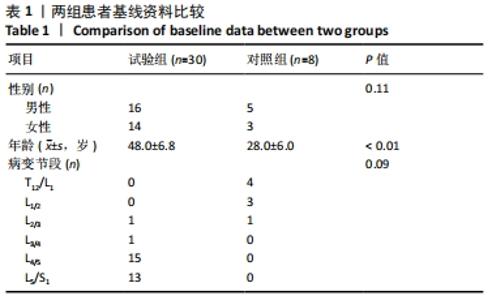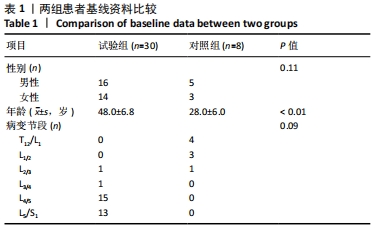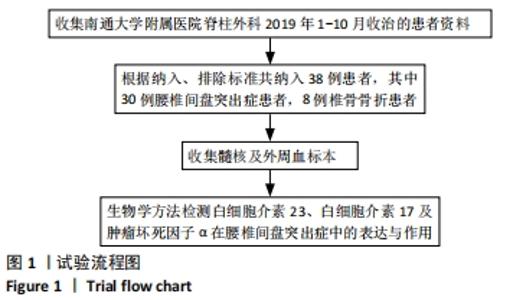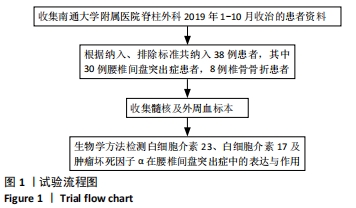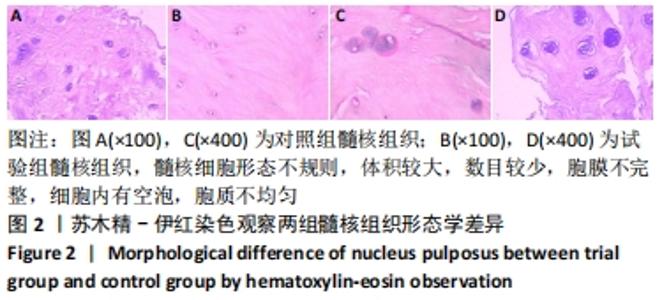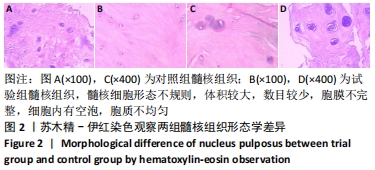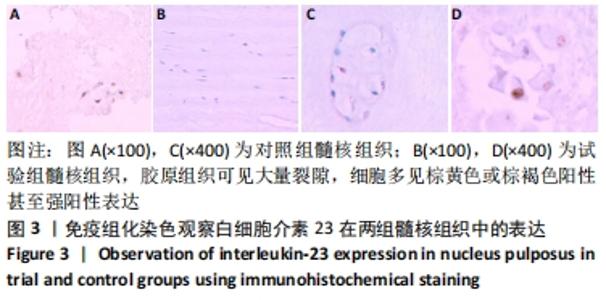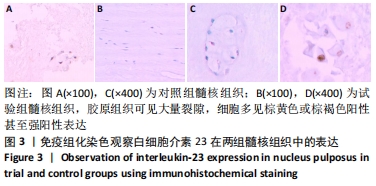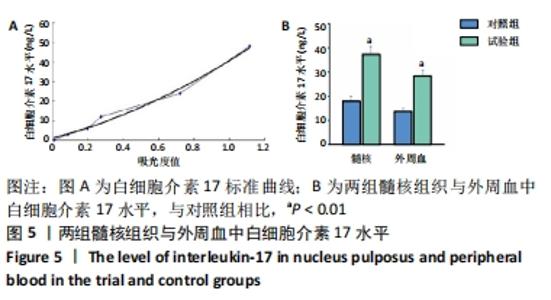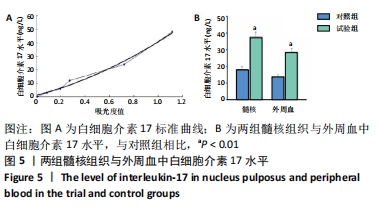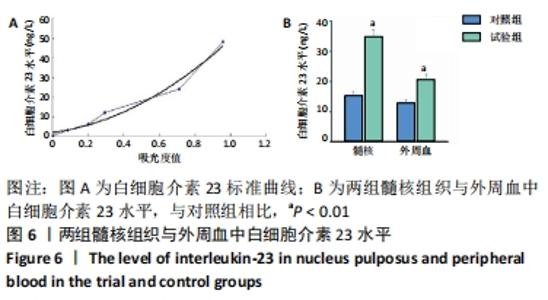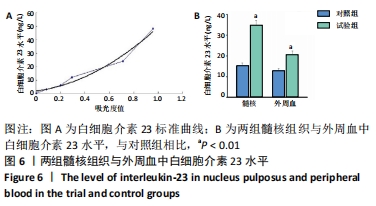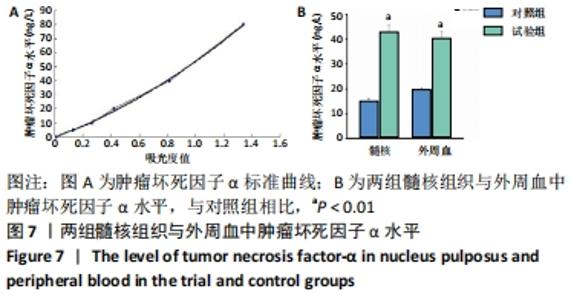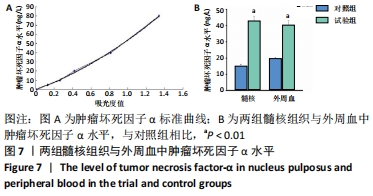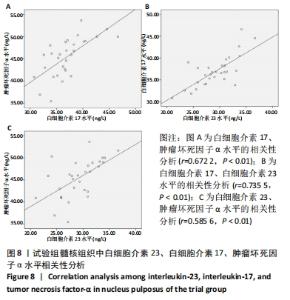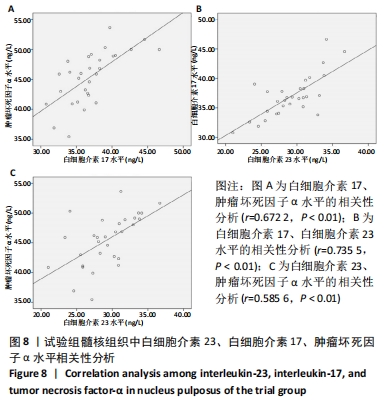Chinese Journal of Tissue Engineering Research ›› 2022, Vol. 26 ›› Issue (14): 2190-2195.doi: 10.12307/2022.482
Previous Articles Next Articles
Correlation between interleukin 23/helper T17 cell axis and lumbar disc herniation
Yang Yang1, Liu Jiajia1, Xue Jianhua1, Liu Yunfei2, Yao Yu3
- 1Trauma Center, Affiliated Hospital of Nantong University, Nantong 226001, Jiangsu Province, China; 2Nantong University, Nantong 226001, Jiangsu Province, China; 3Department of Spine Surgery, Nantong University, Nantong 226001, Jiangsu Province, China
-
Received:2020-11-12Revised:2021-01-16Accepted:2021-08-23Online:2022-05-18Published:2021-12-21 -
Contact:Yao Yu, Master, Associate chief physician, Department of Spine Surgery, Nantong University, Nantong 226001, Jiangsu Province, China -
About author:Yang Yang, Master, Attending physician, Trauma Center, Affiliated Hospital of Nantong University, Nantong 226001, Jiangsu Province, China -
Supported by:the Nantong Municipal Scientific Program, No. MS12018057 (to YY); Science and Technology Project of Nantong Municipal Health Commission, No. MA2020023 (to YY)
CLC Number:
Cite this article
Yang Yang, Liu Jiajia, Xue Jianhua, Liu Yunfei, Yao Yu. Correlation between interleukin 23/helper T17 cell axis and lumbar disc herniation[J]. Chinese Journal of Tissue Engineering Research, 2022, 26(14): 2190-2195.
share this article
Add to citation manager EndNote|Reference Manager|ProCite|BibTeX|RefWorks
| [1] 彭丽丽,余凤娇,王青.康复护理干预对腰椎间盘突出症患者的生活质量影响[J].实用临床医药杂志,2016,20(16):207-209. [2] 曾祥宏,刘兵.腰椎间盘突出症的病因及其机制分析[J].长江大学学报(自然科学版),2010,7(3):72-73. [3] LICHAWSKA-CIESLAR A, KONIECZNY P, SZUKALA W, et al. Loss of keratinocyte Mcpip1 abruptly activates the IL-23/Th17 and Stat3 pathways in skin inflammation. Biochim Biophys Acta Mol Cell Res. 2021;1868(1):118866. [4] LECCESE G, BIBI A, MAZZA S, et al. Probiotic Lactobacillus and Bifidobacterium Strains Counteract Adherent-Invasive Escherichia coli (AIEC) Virulence and Hamper IL-23/Th17 Axis in Ulcerative Colitis, but Not in Crohn’s Disease. Cells. 2020;9(8):1824. [5] EGEBERG A, GISONDI P, CARRASCOSA JM, et al. The role of the interleukin-23/Th17 pathway in cardiometabolic comorbidity associated with psoriasis. J Eur Acad Dermatol Venereol. 2020;34(8):1695-1706. [6] PLAVEC TV, KUCHAŘ M, BENKO A, et al. Engineered Lactococcus lactis Secreting IL-23 Receptor-Targeted REX Protein Blockers for Modulation of IL-23/Th17-Mediated Inflammation. Microorganisms. 2019;7(5):152. [7] HASAN Z, KOIZUMI SI, SASAKI D, et al. JunB is essential for IL-23-dependent pathogenicity of Th17 cells. Nat Commun. 2017;8:15628. [8] PUNKENBURG E, VOGLER T, BÜTTNER M, et al. Batf-dependent Th17 cells critically regulate IL-23 driven colitis-associated colon cancer. Gut. 2016;65(7):1139-1150. [9] REVU S, WU J, HENKEL M, et al. IL-23 and IL-1β Drive Human Th17 Cell Differentiation and Metabolic Reprogramming in Absence of CD28 Costimulation. Cell Rep. 2018;22(10):2642-2653. [10] 张海平,张烽,姚羽.腰椎间盘突出髓核的自身免疫性[J].中国组织工程研究,2012,16(48):8931-8937. [11] ANITUA E, PADILLA S. Biologic therapies to enhance intervertebral disc repair. Regen Med. 2018;13(1):55-72. [12] 赵才勇,何东,刘淼,等.腰椎间盘表观弥散系数与肿瘤坏死因子-α、白细胞介素-6的相关性研究[J].功能与分子医学影像学(电子版), 2016,5(3):34-37. [13] 张潇潇,姜宏,张志刚,等.肿瘤坏死因子与腰椎间盘退变的相关性研究进展[J].中国中医骨伤科杂志,2017,25(12):79-82. [14] 王亮,张照宏.趋化因子CXCL10(IP-10)、MMP-1及TNF-α与腰椎间盘突出症的相关性研究[J].山东医学高等专科学校学报,2015, 37(6):445-447. [15] 安志辉,丁文元,张剑刚,等.退变性腰椎侧凸TNF-α基因多态性和蛋白表达水平的相关研究[J].中国骨与关节杂志,2012,1(4):381-387. [16] 朱书涛,刘洋,张明辉,等.去卵巢大鼠骨组织中肿瘤坏死因子α、白细胞介素1β及白细胞介素6水平与骨质疏松的关系[J].中国组织工程研究,2016,20(15):2206-2211. [17] 孙中仪,田纪伟.白细胞介素与椎间盘退变的研究进展[J].中国矫形外科杂志,2014,22(3):249-252. [18] SPILIOPOULOU I, KOROVESSIS P, KONSTANTINOU D, et al. IgG and IgM concentration in the prolapsed human intervertebral disc and sciatica etiology. Spine (Phila Pa 1976). 1994;19(12):1320-1323. [19] GEISS A, LARSSON K, RYDEVIK B, et al. Autoimmune properties of nucleus pulposus: an experimental study in pigs. Spine (Phila Pa 1976). 2007;32(2):168-173. [20] MABUCHI T, KOJIMA H, ABE T, et al. Membrane-associated prostaglandin E synthase-1 is required for neuropathic pain. Neuroreport. 2004;15(9): 1395-1398. [21] ZAKA M, ABBASI BH, DURDAGI S. Novel tumor necrosis factor-α (TNF-α) inhibitors from small molecule library screening for their therapeutic activity profiles against rheumatoid arthritis using target-driven approaches and binary QSAR models. J Biomol Struct Dyn. 2019; 37(9):2464-2476. [22] JAHID M, REHAN-UL-HAQ, JHA PK, et al. Tumor necrosis factor-α -308 polymorphism in North Indian rheumatoid arthritis patients and association with mRNA and serum TNF-α. Clin Rheumatol. 2017;36(10): 2209-2216. [23] DAI ZH, XU XT, RAN ZH. Associations Between Obesity and the Effectiveness of Anti-Tumor Necrosis Factor-alpha Agents in Inflammatory Bowel Disease Patients: A Literature Review and Meta-analysis. Ann Pharmacother. 2020;54(8):729-741. [24] FARSI F, HESHMATI J, KESHTKAR A, et al. Can coenzyme Q10 supplementation effectively reduce human tumor necrosis factor-α and interleukin-6 levels in chronic inflammatory diseases? A systematic review and meta-analysis of randomized controlled trials. Pharmacol Res. 2019;148:104290. [25] EVANS HG, ROOSTALU U, WALTER GJ, et al. TNF-alpha blockade induces IL-10 expression in human CD4+ T cells. Nat Commun. 2014;5:3199. [26] TAKAHASHI H, SUGURO T, OKAZIMA Y, et al. Inflammatory cytokines in the herniated disc of the lumbar spine. Spine (Phila Pa 1976). 1996; 21(2):218-224. [27] 赵太茂,刘淼,赵文,等. TNF-α、IL- 1β在腰椎间盘突出症中致痛作用的研究[J].颈腰痛杂志,2010,31(3):174-176. [28] ZIELINSKI CE, MELE F, ASCHENBRENNER D, et al. Pathogen-induced human TH17 cells produce IFN-gamma or IL-10 and are regulated by IL-1beta. Nature. 2012;484(7395):514-518. [29] MAGGI E, BISWAS P, DEL PRETE G, et al. Accumulation of Th-2-like helper T cells in the conjunctiva of patients with vernal conjunctivitis. J Immunol. 1991;146(4):1169-1174. [30] 张海平.腰椎间盘突出症与TH细胞极化的相关性研究[D].南通:南通大学,2010:1-48. [31] AGGARWAL S, GHILARDI N, XIE MH, et al. Interleukin-23 promotes a distinct CD4 T cell activation state characterized by the production of interleukin-17. J Biol Chem. 2003;278(3):1910-1914. [32] LANGRISH CL, CHEN Y, BLUMENSCHEIN WM, et al. IL-23 drives a pathogenic T cell population that induces autoimmune inflammation. J Exp Med. 2005;201(2):233-240. [33] PARK H, LI Z, YANG XO, et al. A distinct lineage of CD4 T cells regulates tissue inflammation by producing interleukin 17. Nat Immunol. 2005; 6(11):1133-1141. [34] PARHAM C, CHIRICA M, TIMANS J, et al. A receptor for the heterodimeric cytokine IL-23 is composed of IL-12Rbeta1 and a novel cytokine receptor subunit, IL-23R. J Immunol. 2002;168(11):5699-5708. [35] HARRINGTON LE, HATTON RD, MANGAN PR, et al. Interleukin 17-producing CD4+ effector T cells develop via a lineage distinct from the T helper type 1 and 2 lineages. Nat Immunol. 2005;6(11):1123-1132. [36] MELNIKOV M, SHARANOVA S, SVIRIDOVA A, et al. The influence of glatiramer acetate on Th17-immune response in multiple sclerosis. PLoS One. 2020;15(10):e0240305. [37] KORN T, BETTELLI E, OUKKA M, et al. IL-17 and Th17 Cells. Annu Rev Immunol. 2009;27:485-517. [38] ZHANG H, TAI H, MA Y, et al. Postoperative Serum Levels of Interleukin-1β (IL-1β), Interleukin-17 (IL-17), and Tumor Necrosis Factor-α (TNF-α) in Patients Following Hip Replacement Surgery for Traumatic Fractured Femoral Neck: A Retrospective Study. Med Sci Monit. 2019;25:6120-6127. [39] LEGRAND A, FERMOR B, FINK C, et al. Interleukin-1, tumor necrosis factor alpha, and interleukin-17 synergistically up-regulate nitric oxide and prostaglandin E2 production in explants of human osteoarthritic knee menisci. Arthritis Rheum. 2001;44(9):2078-2083. |
| [1] | Lü Qianyi, Chen Xinyi, Zheng Huie, He Haolong, Li Qilong, Chen Chutao, Tian Haomei. Stress and displacement of normal lumbar vertebra and posterior structure with different elbow pressing methods [J]. Chinese Journal of Tissue Engineering Research, 2022, 26(9): 1346-1350. |
| [2] | Xiang Xinjian, Liu Fang, Wu Liangliang, Jia Daping, Tao Yue, Zhao Zhengnan, Zhao Yu. High-dose vitamin C promotes the survival of autologous fat transplantation in rats [J]. Chinese Journal of Tissue Engineering Research, 2022, 26(8): 1242-1246. |
| [3] | Ma Chao, Wang Fei, Liu Xiaomin, Wang Ziyun, Xu Kui, Yang Wendong, Feng Wei. Quantification of the objective index of lumbar disc herniation with body surface topography map: three-dimensional angulation of the elastically fixed turning point of the lower back curve [J]. Chinese Journal of Tissue Engineering Research, 2022, 26(6): 924-928. |
| [4] | He Junjun, Huang Zeling, Hong Zhenqiang. Interventional effect of Yanghe Decoction on synovial inflammation in a rabbit model of early knee osteoarthritis [J]. Chinese Journal of Tissue Engineering Research, 2022, 26(5): 694-699. |
| [5] | Liu Yiyi, Qiu Junqiang, Yi Longyan, Zhou Cailiang. Effect of resistance training on interleukin-6 and C-reactive protein in middle-age and elderly people: a Meta-analysis [J]. Chinese Journal of Tissue Engineering Research, 2022, 26(5): 804-812. |
| [6] | Wang Nan, Qian Yuzhang, Xie Lin. Network Meta-analysis of different acupuncture methods for the treatment of lumbar disc herniation [J]. Chinese Journal of Tissue Engineering Research, 2022, 26(5): 813-820. |
| [7] | Li Anan, Jiang Tao, Zhan Min, Cai Yuning, Song Min, Li Congcong, Lin Wenzheng, Zhang Jiayuan, Liu Wengang. Pharmacological mechanism of Shenling Baizhu San in the treatment of knee osteoarthritis based on network pharmacology and molecular docking [J]. Chinese Journal of Tissue Engineering Research, 2022, 26(2): 197-204. |
| [8] | Liu Jie, Wang Min. Changes in programmed necrosis pathway in the occurrence and development of periapical periodontitis in a mouse model [J]. Chinese Journal of Tissue Engineering Research, 2022, 26(14): 2179-2183. |
| [9] | Zhao Jiling, Peng Yi, Peng Zhiyong, Yu Guolong. Effects of human umbilical cord blood mesenchymal stem cells secreting tumor necrosis factor alpha stimulating gene-6 protein on conversion of mouse bone marrow-derived macrophage subtypes [J]. Chinese Journal of Tissue Engineering Research, 2022, 26(13): 2012-2019. |
| [10] | Yin Xunlu, Jin Zhefeng, Zhu Liguo, Feng Minshan, Yu Jie, Wei Xu, Zhan Jiawen, Gao Chunyu, Yin He, Liang Long, Han Tao, Sun Kai, Xie Rui . Effect and mechanism of mechanical factors on intervertebral disc degeneration [J]. Chinese Journal of Tissue Engineering Research, 2022, 26(12): 1816-1821. |
| [11] | Xing Hongchang, Cao Jianping, Zhu Jing, Yao Kun. Mechanism by which enalapril alleviates myocardial injury in a rat model of limb ischemia-reperfusion [J]. Chinese Journal of Tissue Engineering Research, 2022, 26(11): 1747-1751. |
| [12] | Yang Tengyun, Li Yanlin, Liu Dejian, Wang Guoliang, Zheng Zhujun. Chondrogenic differentiation of peripheral blood-derived mesenchymal stem cells induced by transforming growth factor beta 3: a dose-effect relationship [J]. Chinese Journal of Tissue Engineering Research, 2022, 26(1): 45-51. |
| [13] | Zhao Xu, Mao Xin, Li Chuntian, Wang Feng. Effect of mesenchymal stem cells on myocardial ischemia-reperfusion injury [J]. Chinese Journal of Tissue Engineering Research, 2022, 26(1): 130-134. |
| [14] | Lü Zhen, Bai Jinzhu. A prospective study on the application of staged lumbar motion chain rehabilitation based on McKenzie’s technique after lumbar percutaneous transforaminal endoscopic discectomy [J]. Chinese Journal of Tissue Engineering Research, 2021, 25(9): 1398-1403. |
| [15] | Gu Xia, Zhao Min, Wang Pingyi, Li Yimei, Li Wenhua. Relationship between hypoxia inducible factor 1 alpha and hypoxia signaling pathway [J]. Chinese Journal of Tissue Engineering Research, 2021, 25(8): 1284-1289. |
| Viewed | ||||||
|
Full text |
|
|||||
|
Abstract |
|
|||||
